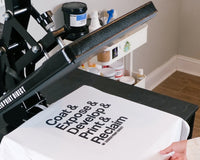Are you ready to make your screen printing hobby a business? Or maybe you are already printing for profit and want to take the next step. If you're thinking of starting a serious business out of screen printing, it's important to create a business plan to help guide you towards success. Here are the steps you can take to create a comprehensive business plan for your screen printing shop.
1. Executive Summary:
Start with a brief summary of your business plan, highlighting the most important aspects of your business, such as your mission statement, the products and services you'll offer, your target market, and your projected revenue.
The purpose of the executive summary is to give readers a quick and clear understanding of the business and its potential for success, which can encourage them to read the rest of the plan in more detail. The executive summary is therefore a critical part of the business plan and should be crafted carefully to make a strong impression and to generate interest in the business.
Although this section is first, we suggest writing it last. Once you complete the steps below you will have a better picture of your business and summarizing will be easier.
2. Company Description:
Provide a detailed overview of your screen printing shop, including the name of your business, its legal structure, location, and a brief history of how you came up with the idea. Explain your vision for your business and your long-term goals.
You will need to select the type of structure your business will operate under. There are several legal structures that screen printing businesses can choose from, depending on their specific needs and goals. Here are some of the most common legal structures:
- Sole Proprietorship: This is the simplest and most common legal structure for small businesses. A sole proprietorship is owned and operated by a single individual who is personally responsible for the business's debts and liabilities.
- Partnership: A partnership is a legal structure in which two or more people own and operate a business. Each partner is personally responsible for the business's debts and liabilities.
- Limited Liability Company (LLC): An LLC is a hybrid legal structure that combines elements of a partnership and a corporation. It offers personal liability protection to its owners (called members), while also allowing for pass-through taxation, meaning that the business's profits and losses are reported on the members' personal tax returns.
- Corporation: A corporation is a legal entity that is separate from its owners. It is owned by shareholders and is managed by a board of directors. Corporations offer personal liability protection to their shareholders, but are subject to double taxation, meaning that the business's profits are taxed at the corporate level and again at the individual level when they are distributed to shareholders.
The legal structure that is best for a screen-printing business will depend on a variety of factors, including the number of owners, the level of personal liability protection desired, and the tax implications of the different structures. It is important to consult with an account if you are unsure of which to choose, they can help you pick the option best for your unique financial situation.
Let’s talk about goals! Where do you see your business in 5 or 10 years, it is important to establish goals now so you can start to measure your success and progress against these goals. Here are some examples of goals you can set for your screen printing business.
- Increase Revenue and profitability – Set a goal to generate x amount of revenue by year 5
- Expand your product offering –In 3 years you will offer embroidery and sublimation printing
- Scale your shop size – By year 10 you will own an automatic machine and employee 20 persons
3. Market Analysis:
Conduct market research to understand your industry and your target market. Identify your competitors, analyze their strengths and weaknesses, and determine how you can differentiate your screen-printing shop from others in the market.
This is your space to analyze and then get creative. How can your shop stand out amongst all the other printing services offered? Focus on what you can do different. What value can you bring customers that others can not?
4. Products and Services:
Outline the products and services you'll offer, such as t-shirts, hoodies, and other types of apparel. Explain how you'll create and produce these products, and the pricing strategy you'll use.
They sky is the limit here. There are so many services you can offer customers as well as different garment offerings. We suggest you first establish a smaller niche and then expand your offering as you grow. Its much easier to market a niche than it is a large category. Nail down your niche, then grow.
5. Marketing and Sales:
Describe how you'll promote and sell your products and services. Identify the channels you'll use, such as social media, email marketing, and word-of-mouth. Explain how you'll price your products and services, and how you'll handle payments and orders.
We have a great blog post that goes into depth about marketing your screen printing business. This blog shares free marketing suggestions as well as paid. Read here.
6. Operations and Management:
Describe how your screen printing shop will operate, including the equipment you'll need, the employees you'll hire, and the systems you'll use to manage your business. Include information on how you'll handle inventory, production, and quality control.
If you plan to start as a one man show, that’s great. Include this in the plan and perhaps your goals on growing your staff if you are interested in employing others.
7. Financial Plan:
Create a financial plan for your screen printing shop, including your startup costs, projected revenue, and expenses. Estimate your profitability over the first few years of operation, and include a break-even analysis. You should also include a cash flow statement and balance sheet.
Here are some financial information resources:
How to Prepare a Cash Flow Statement from Havard Business School
How to Prepare a Balance Sheet from Harvard Business School
Does everything above sound like gibberish? I get it, Im not a numbers person either. I suggest hiring a freelancer rom upwork to help you prepare these statements. This can be done fairly cheap and it saves you from a headache
8. Appendix:
Include any supporting documentation, such as market research data, legal documents, and financial projections that were mentioned in the plan above.
By following these steps, you'll create a comprehensive business plan for your screen printing shop that will help guide you towards success. Remember to review and update your plan regularly as your business evolves.







